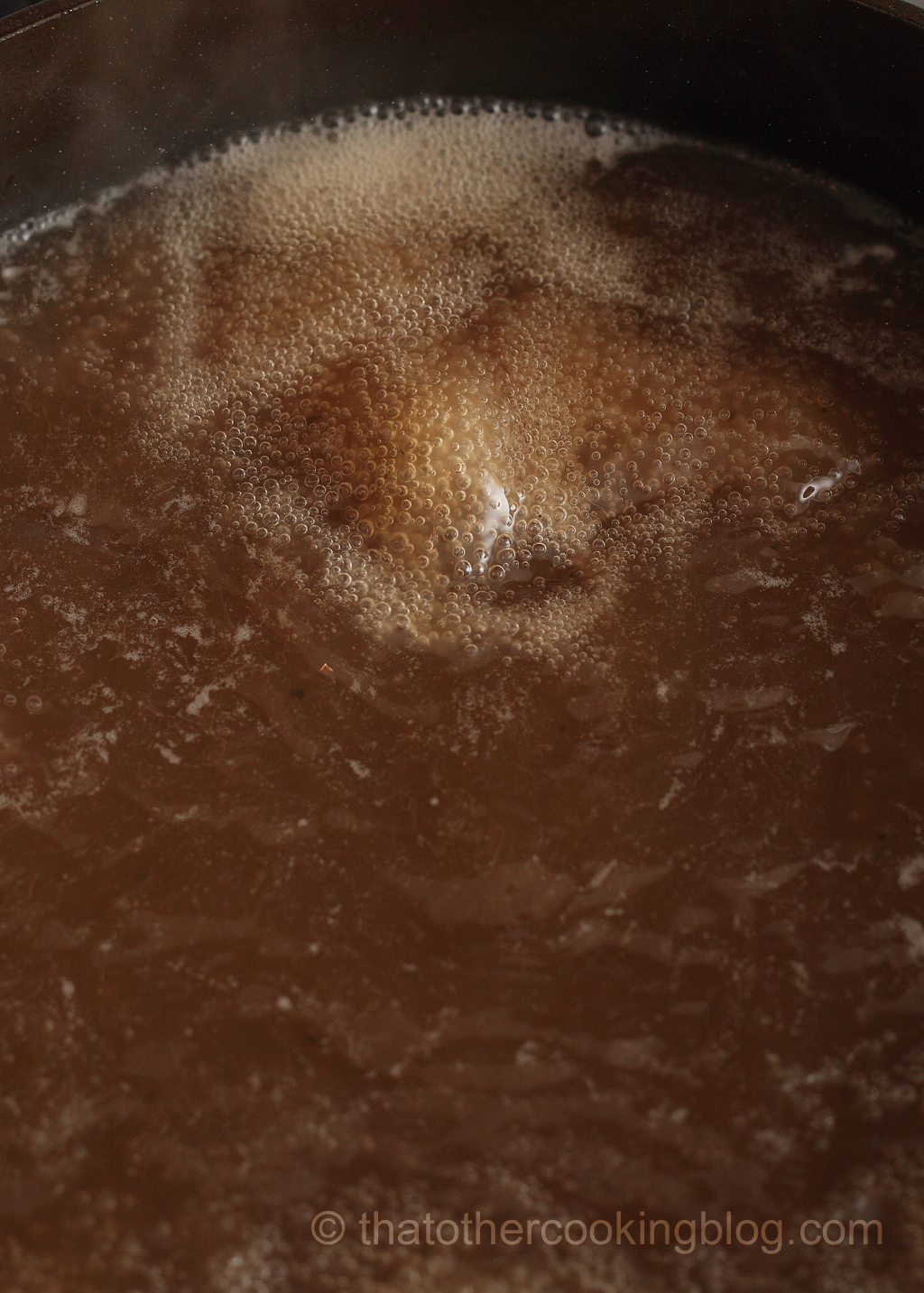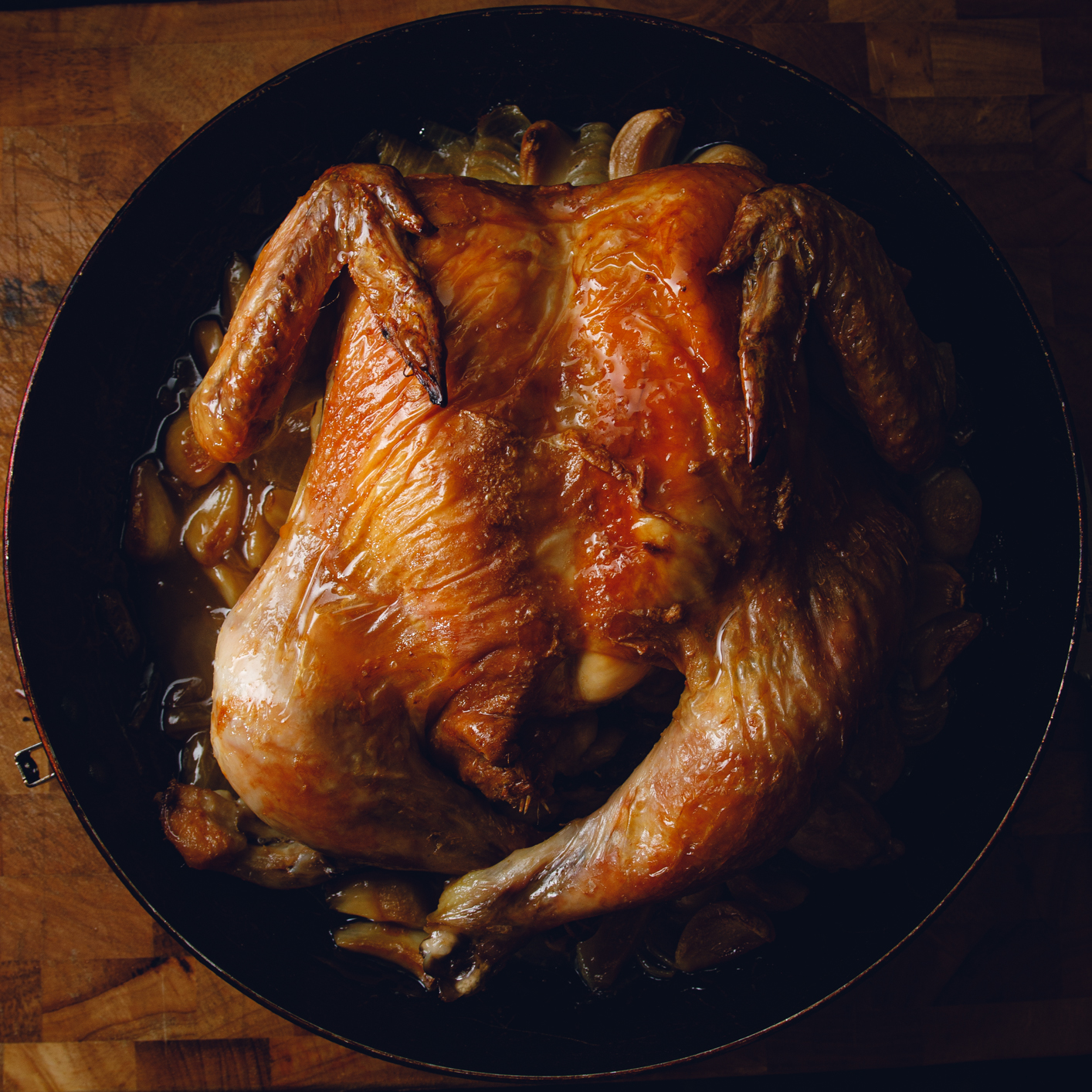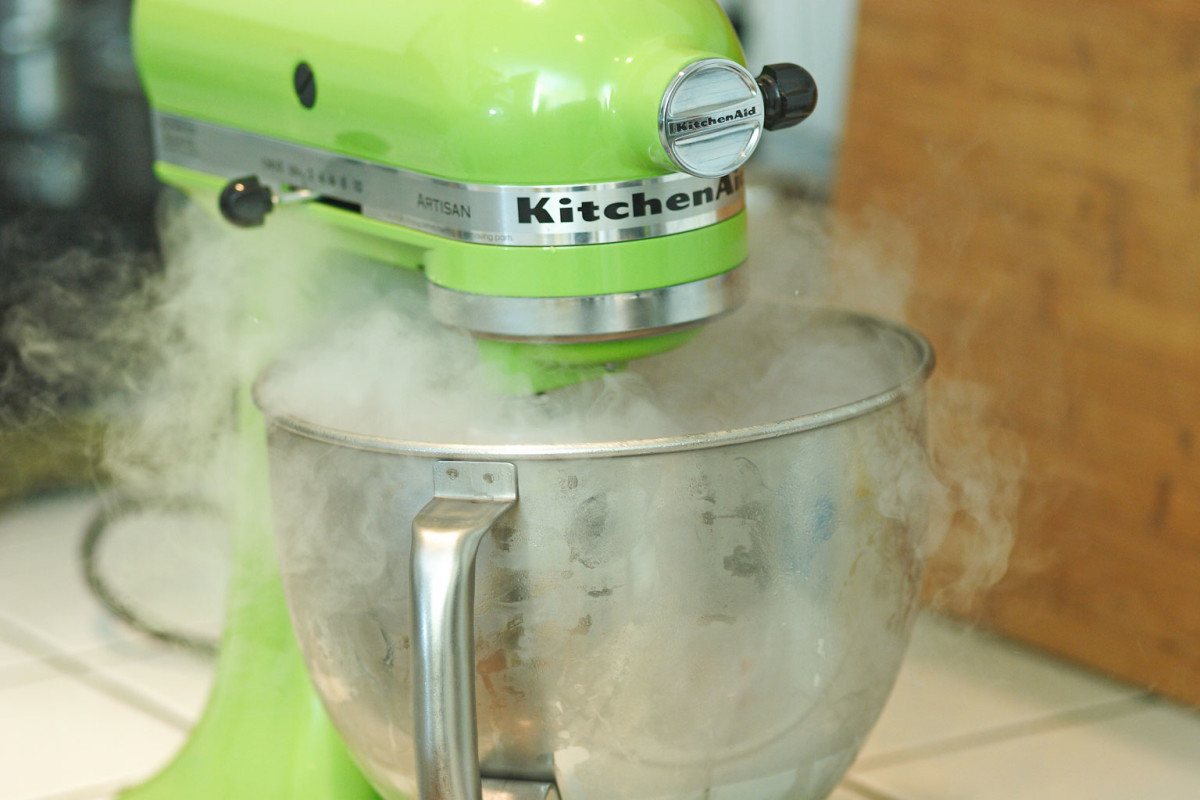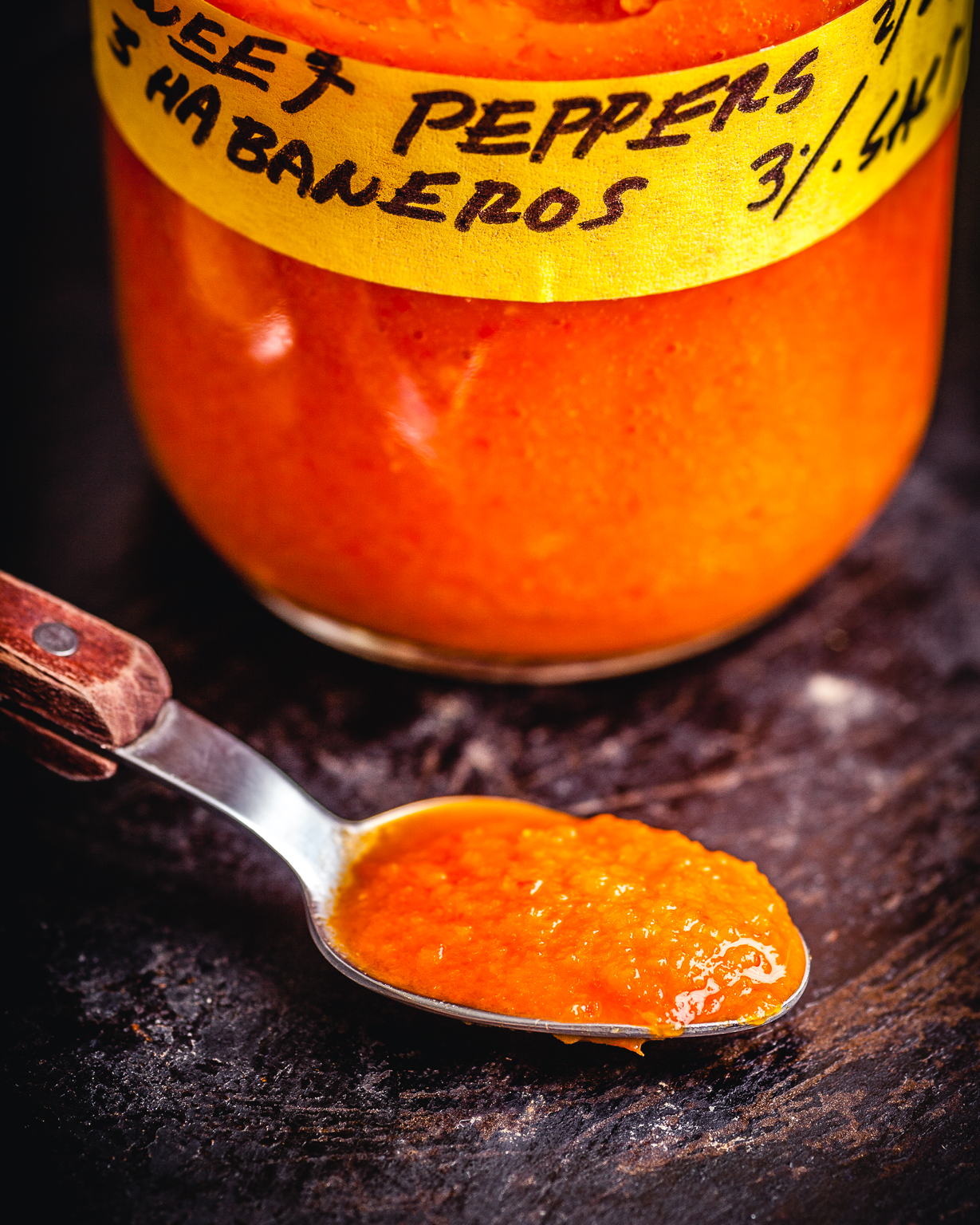Making your own stock is one of the simplest and most useful things any cook can learn. Observing a few things you can make flavorful stocks very easily. In this post I’m going over how to make brown chicken stock and cover a few more general related tips. Making stocks… I took this subject for granted for the longest time. Yeah, those were the bouillon cube days… long gone… well, sometimes I use them as well as store bought stock, they happen to be very very practical and there are some good brands out there, but when I have the time and material at hand. I make my own stocks.
For me there are a few reasons to make your own stock:
1. Minimizing ingredient waste:
Finding a great application for scraps, carcasses, skins, peels. Things that you’d otherwise throw away can find a good place in a stock pot. Say you roast a chicken, well, most everything you end up not eating can be used for making chicken stock. The skin provide incredible flavor and so do the giblets. Always make sure your ingredients are fresh and never use spoiled anything.
2. Controlling flavor:
You have a lot of control. You can use leeks instead of onions if you feel like it, maybe both. Or not use the chicken livers if you don’t like their taste. You can skip using salt all together and keep your stock unsalted until it is time to season when you’re ready. With store bought stuff, food ends up tasting like whoever came up with the recipe on the box/can. When I was getting into cooking, one of the things I that remember improved everything was the fact that I stopped using bouillon cubes or canned stock. All of a sudden food stopped tasting the same all the time. It was liberating! I know this might be obvious to most of you, but it wasn’t to me at the time.
3. Storability:
Storing a liquid is a lot more convenient than storing a bunch of bones in the freezer, right? how about vegetables? they wilt pretty fast, right? Freezing vegetables can be time and space consuming, some lend themselves better than others to be frozen and you’ll need to read about the proper way them prep them for storage. Up to you and the application you have in mind. Stock freezes wonderfully. If you know you have a bunch of veggies you wont be able to use and are every likely to end up in the trash can, you can make stock and freeze it.
These seem to me like pretty good reasons to put those knorr cubes away and tackle this issue armed with a knife and a pot!
Ingredients:
Leftover chicken from a roast or chicken giblets, excess skins, fatty bits and carcass
Mirepoix Veggies: 1 white onion, 1 or 2 celery stalks, 1 large carrot, bay leaf, 1 thyme sprig, 1 rosemary sprig.
You can get pretty creative with the veggies and the herbs, don’t get too creative with seasoning though. Keep that to a minimum.
No salt. No pepper. (at least that’s my recommendation)
Method:
Place some chicken bones, skins, giblets on a roasting pan (or roast a whole chicken!). Make sure you dry them with paper towels. We need them dry so they roast quickly. If they’re wet, they’ll steam instead. Line the tray with tin foil. Less mess. We’re gonna make a brown stock, which means browning our ingredients. Yields a deeper flavor and color. Sometimes we don’t want that, and we will simmer our ingredients without browning in which case is called a white stock. Fish stock is called a fish fumet and are usually white stocks as are shell fish stocks.
You can toss the chicken in some olive oil, vegetable oil, or melted butter or coat it with a brush like I did. Whatever fits your style. Coating the chicken with fat will speed up browning and make it more even.
Roast for about 30 minutes at 400F. Check a few times making sure nothing is burning. Baste if needed. Turn any piece that might be looking to dark. I can’t stress this enough. Anything burns, might as well throw the whole thing in the trash.
Place the roasted chicken parts inside a stock pot or in this case, a pressure cooker. I basically grabbed the tin foil, and transferred the whole thing into the pot, fat and all. If there are a lot of browned bit stock to the foil, I suggest you degalze that and add it to the pot as well. You can crack the chicken bones if you want better access to the marrow inside. It adds more flavor this way.
Fill the pot with enough water to cover the chicken and simmer for about 2 hours max if using a traditional stock pot. In the pressure cooker, is about 40 minutes to an hour at 15 psi. A very important thing to keep in mind. Overcooking any stock will yield a bitter stock. Calcium from the bones will cloud the stock and over denaturing of proteins will give an unpleasant flavor.
A quick guideline for traditional approximate cooking times:
Beef stock (from bones): 6-8 hours or 2 1/2 pressure cooked.
Beef trimmings: 1 hour or 20 minutes pressure cooked.
Chicken stock: 2 hour or 40 mins pressure cooked.
Fish stock (non-fatty fish bones/heads): 20-30 minutes. Why bother pressure cooking, is so quick already 🙂
Shell fish stock (crab, shrimp, lobster heads and shells) : 15-20 mins. Why bother pressure cooking, is so quick already 🙂
Vegetables: 1 1/2 hours. 30-40 mins pressure cooked.
When the time’s up, the stock is pretty much ready. You can at this point dispose of the chicken, it will pretty much have no flavor left in it. Where are the veggies? Well.. that’s coming up. You can render stocks separately and then combine it or do them at the same time. Sometimes I don’t have aromatics at hand. Being able to extract the flavor of one ingredient in the absence of the others is very convenient. I would still recommend combining all the ingredients together when making stock, but for the purpose of this post, I think separating them is kinda cool.
Strain the stock and pour it into a container. You could line your strainer with kitchen towel to better filter out any solids. While the stock is hot, the fats and the liquid gelatin are sort of floating around together, but once you chill it, the fats will surface and solidify. The underneath substance is basically chicken gelatin that should be fairly liquid since the water content is still very high. Chilling the stock is the way to go in my opinion for de-fatting. Why remove the fat? well, chicken stock yields a lot of fat, we wouldn’t want all of that in say chicken soup or a risotto. We can remove it, store it and use it later if we want. But the stock should mainly be chicken flavored water. Once the fat is hard, scrape it away with a spoon or whatever weapon of your choice.
Chicken stock to the left. Rich chicken schmaltz to the right.
Vegetable stock can now be rendered and combined with our chicken stock to add more flavor complexity. The procedure is similar. I made a white veggie stock, which means, I didn’t caramelize the veggies. I simply added them to the pot, added enough water to cover them and pressure cooked them for about 30 minutes which is enough to extract all the flavor. There’s no fat in this stock, so no de-fatting required. I used some leeks, carrots, celery, garlic.. I even used a salad green mix that I knew I was probably gonna throw away. It had iceberg lettuce, radishes, sugar peas, etc.
Once I had both stocks ready. I reduced each of them by half to intensify the flavor, and then added vegetable stock to the chicken stock by the tablespoon until I was happy with the flavor. Tasting food without salt is probably a good exercise to better understand the subtleties of flavor. I think we become a little to dependent on salt to taste flavor in ingredients and preparations.
With this chicken/vegetable stock I put prepared a chicken noodle soup which I will be writing about in the next post. Until then, I hope you’ve enjoyed this simple chicken brown stock 101 post. More coming up soon! Take care fellow cauldron stirrers!
Wanna get more sous-vide cooking guides and cool cooking how-to’s in your mailbox? You know what needs to be done!
We never spam. You should only be getting updates when new content is posted on the site. We also respect your privacy. We don’t share your email address with anyone and you can unsubscribe anytime!















23 comments
I am not sure I would call this ‘simple’, But it does look AMAZING!!!!!!!
Lotis, it is super simple! 🙂 thanks!!!
Beautiful stock. I can’t imagine not making my own, just so flavorful and as you said a great way to use up scraps. This was one of the first things I learned in culinary school.
Cheryl, thanks! btw… I’m still giggling from reading your last post! that was extremely amusing. I didn’t know you had gone to culinary school, I wish I had gone to culinary school. What was I thinking computer science… yikes!
Very informative post with beautiful pictures! I try to make my own stocks whenever I can. I want to get a pressure cooker badly and can’t wait to use it make stocks when I am shorter on time!
thanks Jess! i think the pressure cooker is the thing I use the most in the kitchen. not only because they speed things up, stuff tastes more flavorful too. Maybe it is because the smell doesn’t escape the vessel? no idea 🙂
So I’m leaning towards getting an electric pressure cooker just because that way I keep another burner free and it could also replace my slow cooker but I’m not really sure. Do you know much about the advantages or either kind?
I’ve read reviews on the electric ones and I wasn’t too impressed. They are clunkier and heavier and more difficult to wash. Here’s what I did. I bought an induction stove, single stove, is portable, and I have my pressure cooker sitting on it all the time. I can use the induction stove with other stainless steel, or cast iron ware as well. I love how you can deglaze the bottom or the pressure cooker (stainless steal creates great fond) just like a skillet. You wouldn’t have the incorporated timer that comes with some models, but I have 2 timers I use for when I bake/roast/reduce..etc, so I don’t think I need more timers 🙂
Hmmm… good idea! I will take that into consideration when I got to buy one! I can’t wait to try using one!!!
Good post 🙂
P.S. Store-bought stock can be okay, but I’ve never seen good cubes.
thanks Stefan! I will still keep a few cubes in my first aid kit whenever I go camping 🙂
Ewww is all I can say 😉
hahah!
What an informative post. I didn’t know the difference between brown and white stock. I usually make my chicken stock in the slow cooker. First I’ll make a whole chicken in there, then take the meat off the bones, break them up and pop them back in with the skins and the liquid that was produced during cooking. Add a few veggies and top up with water… another 8 hours or so on low and done! Your method is way more sophisticated and probably much tastier, thanks for sharing!
Thank you! So glad you found this helpful but I have to ask about your 8 hour stock, is it a tiny bit bitter? From what I’ve read, stocks can be overcooked because protein denatures and breaks down eventually which yields a bitter taste, but I’ve never cooked mine for so long so all I have is what I’ve read. I dig that fact that you break the bones… That’s pro! 🙂
Well the slow cooker doesn’t cook at the same temperature as the stovetop, so you can’t compare the cooking times. Nearly all meats and root veggies need about 8 hrs as well (on low). I haven’t noticed any bitterness but I will do more taste testing after reading your post! I started breaking the bones after I read about the tasty marrow I was missing out on. It also helps jellify the stock. I also read that chicken feet are great for this but I draw the line there..!
you’re right, the slow cooking temperature should totally work really well. I’ve been meaning to come up with a chicken bone marrow dish. I really like the taste, and I know beef marrow is popular but not chicken marrow. I see potential there! Chicken feet? bring it. I have never cooked them, but I don’t see why not. There’s this restaurant in spain that makes a dish using rooster comb, and critics say is amazing… 🙂
haha, you’re a total pro!
hahahaha!